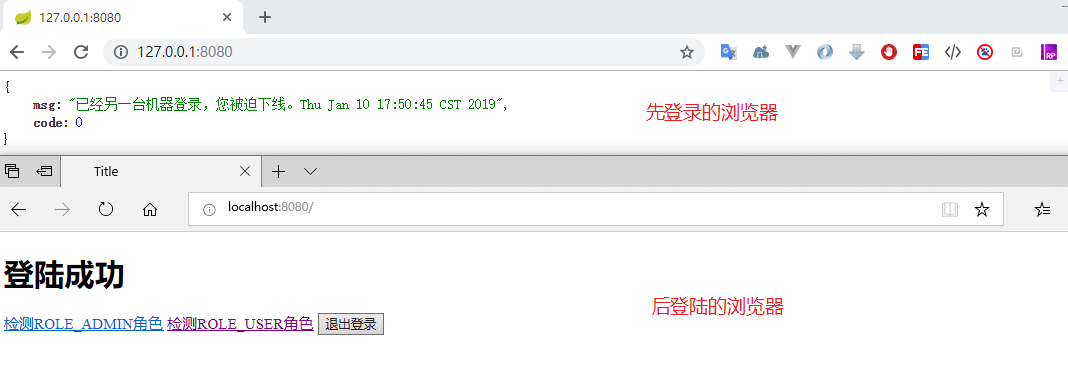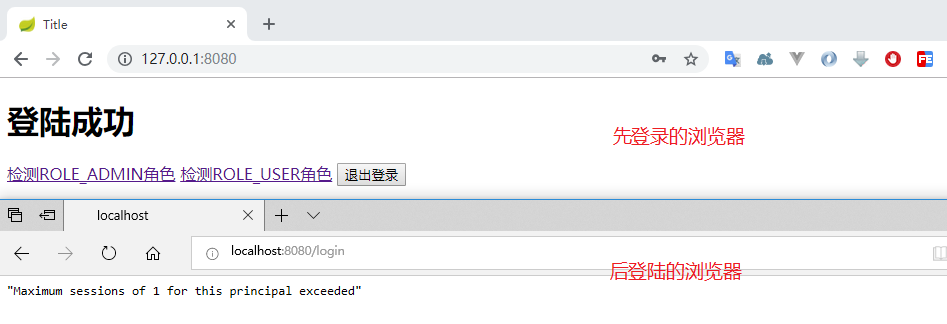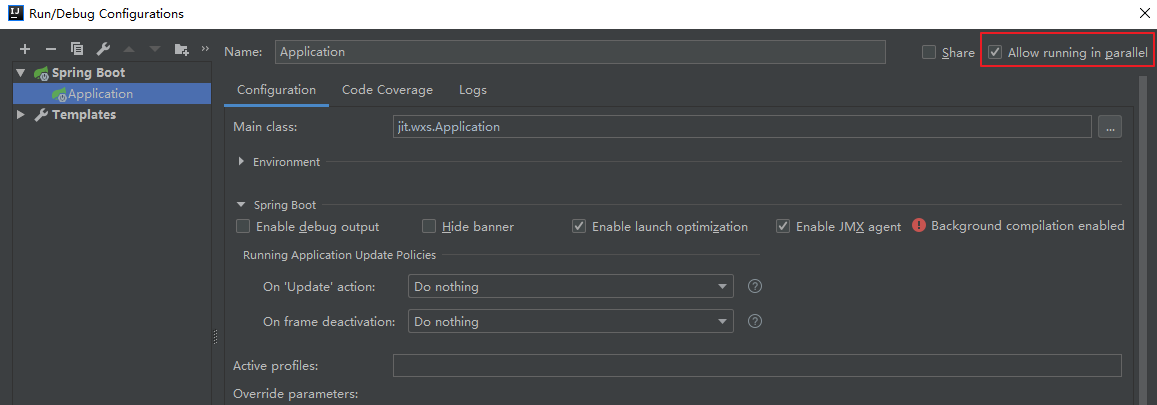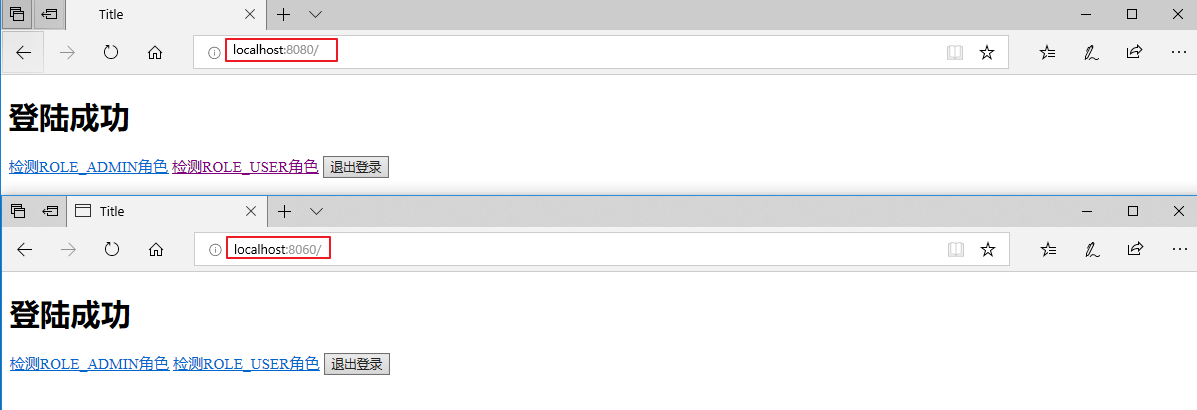文章目录
一、自定义认证成功、失败处理
1.1 CustomAuthenticationSuccessHandler
1.2 CustomAuthenticationFailureHandler
1.3 修改 WebSecurityConfig
1.4 运行程序
二、Session 超时
三、限制最大登录数
四、踢出用户
五、退出登录
六、Session 共享
6.1 配置 Redis
6.2 配置 Session 共享
6.3 运行程序
在本篇中,主要关注登录的管理,因此代码使用最原始版本的即可,即《SpringBoot集成Spring Security(1)——入门程序》源码即可。
源码地址:https://github.com/jitwxs/blog_sample
一、自定义认证成功、失败处理
有些时候我们想要在认证成功后做一些业务处理,例如添加积分;有些时候我们想要在认证失败后也做一些业务处理,例如记录日志。
在之前的文章中,关于认证成功、失败后的处理都是如下配置的:
http.authorizeRequests() // 如果有允许匿名的url,填在下面 // .antMatchers().permitAll() .anyRequest().authenticated().and() // 设置登陆页 .formLogin().loginPage("/login") .failureUrl("/login/error") .defaultSuccessUrl("/") .permitAll() ...;
即 failureUrl() 指定认证失败后Url,defaultSuccessUrl() 指定认证成功后Url。我们可以通过设置 successHandler()和 failureHandler() 来实现自定义认证成功、失败处理。
PS:当我们设置了这两个后,需要去除 failureUrl() 和 defaultSuccessUrl() 的设置,否则无法生效。这两套配置同时只能存在一套。
1.1 CustomAuthenticationSuccessHandler
自定义 CustomAuthenticationSuccessHandler 类来实现 AuthenticationSuccessHandler 接口,用来处理认证成功后逻辑:
@Component public class CustomAuthenticationSuccessHandler implements AuthenticationSuccessHandler { private Logger logger = LoggerFactory.getLogger(getClass()); @Override public void onAuthenticationSuccess(HttpServletRequest request, HttpServletResponse response, Authentication authentication) throws IOException, ServletException { logger.info("登录成功,{}", authentication); response.sendRedirect("/"); } }
onAuthenticationSuccess() 方法的第三个参数 Authentication 为认证后该用户的认证信息,这里打印日志后,重定向到了首页。
1.2 CustomAuthenticationFailureHandler
自定义 CustomAuthenticationFailureHandler 类来实现 AuthenticationFailureHandler 接口,用来处理认证失败后逻辑:
@Component public class CustomAuthenticationFailureHandler implements AuthenticationFailureHandler { @Autowired private ObjectMapper objectMapper; private Logger logger = LoggerFactory.getLogger(getClass()); @Override public void onAuthenticationFailure(HttpServletRequest request, HttpServletResponse response, AuthenticationException exception) throws IOException, ServletException { logger.info("登陆失败"); response.setStatus(HttpStatus.INTERNAL_SERVER_ERROR.value()); response.setContentType("application/json;charset=UTF-8"); response.getWriter().write(objectMapper.writeValueAsString(exception.getMessage())); } }
onAuthenticationFailure()方法的第三个参数 exception 为认证失败所产生的异常,这里也是简单的返回到前台。
1.3 修改 WebSecurityConfig
@Configuration @EnableWebSecurity @EnableGlobalMethodSecurity(prePostEnabled = true) public class WebSecurityConfig extends WebSecurityConfigurerAdapter { @Autowired private CustomAuthenticationSuccessHandler customAuthenticationSuccessHandler; @Autowired private CustomAuthenticationFailureHandler customAuthenticationFailureHandler; ... @Override protected void configure(HttpSecurity http) throws Exception { http.authorizeRequests() // 如果有允许匿名的url,填在下面 // .antMatchers().permitAll() .anyRequest().authenticated().and() // 设置登陆页 .formLogin().loginPage("/login") .successHandler(customAuthenticationSuccessHandler).permitAll() .failureHandler(customAuthenticationFailureHandler) // .failureUrl("/login/error") // .defaultSuccessUrl("/") .permitAll() ...; // 关闭CSRF跨域 http.csrf().disable(); } ... }
- 首先将 customAuthenticationSuccessHandler 和 customAuthenticationFailureHandler注入进来
- 配置 successHandler() 和 failureHandler()
- 注释 failureUrl() 和 defaultSuccessUrl()
1.4 运行程序
运行程序,当我们成功登陆后,发现日志信息被打印出来,页面被重定向到了首页:

当我们认证失败后,发现日志中“登陆失败”被打印出来,页面展示了认证失败的异常消息:

二、Session 超时
当用户登录后,我们可以设置 session 的超时时间,当达到超时时间后,自动将用户退出登录。
Session 超时的配置是 SpringBoot 原生支持的,我们只需要在 application.properties 配置文件中配置:
# session 过期时间,单位:秒
server.servlet.session.timeout=60
Tip:
从用户最后一次操作开始计算过期时间。
过期时间最小值为 60 秒,如果你设置的值小于 60 秒,也会被更改为 60 秒。
我们可以在 Spring Security 中配置处理逻辑,在 session 过期退出时调用。修改 WebSecurityConfig 的 configure()方法,添加:
.sessionManagement() // 以下二选一 //.invalidSessionStrategy() //.invalidSessionUrl();
Spring Security 提供了两种处理配置,一个是 invalidSessionStrategy(),另外一个是 invalidSessionUrl()。
这两个的区别就是一个是前者是在一个类中进行处理,后者是直接跳转到一个 Url。简单起见,我就直接用 invalidSessionUrl()了,跳转到 /login/invalid,我们需要把该 Url 设置为免授权访问, 配置如下:
@Override protected void configure(HttpSecurity http) throws Exception { http.authorizeRequests() // 如果有允许匿名的url,填在下面 .antMatchers("/login/invalid").permitAll() .anyRequest().authenticated().and() ... .sessionManagement() .invalidSessionUrl("/login/invalid"); // 关闭CSRF跨域 http.csrf().disable(); }
在 controller 中写一个接口进行处理:
@RequestMapping("/login/invalid")
@ResponseStatus(HttpStatus.UNAUTHORIZED)
@ResponseBody
public String invalid() {
return "Session 已过期,请重新登录";
}
运行程序,登陆成功后等待一分钟(或者重启服务器),刷新页面:

三、限制最大登录数
接下来实现限制最大登陆数,原理就是限制单个用户能够存在的最大 session 数。
在上一节的基础上,修改 configure() 为:
.sessionManagement() .invalidSessionUrl("/login/invalid") .maximumSessions(1) // 当达到最大值时,是否保留已经登录的用户 .maxSessionsPreventsLogin(false) // 当达到最大值时,旧用户被踢出后的操作 .expiredSessionStrategy(new CustomExpiredSessionStrategy())
增加了下面三行代码,其中:
- maximumSessions(int):指定最大登录数
- maxSessionsPreventsLogin(boolean):是否保留已经登录的用户;为true,新用户无法登录;为 false,旧用户被踢出
- expiredSessionStrategy(SessionInformationExpiredStrategy):旧用户被踢出后处理方法
maxSessionsPreventsLogin()可能不太好理解,这里我们先设为 false,效果和 QQ 登录是一样的,登陆后之前登录的账户被踢出。
编写 CustomExpiredSessionStrategy 类,来处理旧用户登陆失败的逻辑:
public class CustomExpiredSessionStrategy implements SessionInformationExpiredStrategy { private ObjectMapper objectMapper = new ObjectMapper(); // private RedirectStrategy redirectStrategy = new DefaultRedirectStrategy(); @Override public void onExpiredSessionDetected(SessionInformationExpiredEvent event) throws IOException, ServletException { Map<String, Object> map = new HashMap<>(16); map.put("code", 0); map.put("msg", "已经另一台机器登录,您被迫下线。" + event.getSessionInformation().getLastRequest()); // Map -> Json String json = objectMapper.writeValueAsString(map); event.getResponse().setContentType("application/json;charset=UTF-8"); event.getResponse().getWriter().write(json); // 如果是跳转html页面,url代表跳转的地址 // redirectStrategy.sendRedirect(event.getRequest(), event.getResponse(), "url"); } }
在 onExpiredSessionDetected() 方法中,处理相关逻辑,我这里只是简单的返回一句话。
执行程序,打开两个浏览器,登录同一个账户。因为我设置了 maximumSessions(1),也就是单个用户只能存在一个 session,因此当你刷新先登录的那个浏览器时,被提示踢出了。
下面我们来测试下 maxSessionsPreventsLogin(true) 时的情况,我们发现第一个浏览器登录后,第二个浏览器无法登录:

四、踢出用户
下面来看下如何主动踢出一个用户。
首先需要在容器中注入名为 SessionRegistry 的 Bean,这里我就简单的写在 WebSecurityConfig 中:
@Bean public SessionRegistry sessionRegistry() { return new SessionRegistryImpl(); }
修改 WebSecurityConfig 的 configure() 方法,在最后添加一行 .sessionRegistry():
public class WebSecurityConfig extends WebSecurityConfigurerAdapter { ... @Bean public SessionRegistry sessionRegistry() { return new SessionRegistryImpl(); } @Override protected void configure(HttpSecurity http) throws Exception { http.authorizeRequests() // 如果有允许匿名的url,填在下面 .antMatchers("/login/invalid").permitAll() .anyRequest().authenticated().and() // 设置登陆页 .formLogin().loginPage("/login") .successHandler(customAuthenticationSuccessHandler) .failureHandler(customAuthenticationFailureHandler) .permitAll().and() .logout().and() .sessionManagement() .invalidSessionUrl("/login/invalid") .maximumSessions(1) // 当达到最大值时,是否保留已经登录的用户 .maxSessionsPreventsLogin(false) // 当达到最大值时,旧用户被踢出后的操作 .expiredSessionStrategy(new CustomExpiredSessionStrategy()) .sessionRegistry(sessionRegistry()); // 关闭CSRF跨域 http.csrf().disable(); } }
编写一个接口用于测试踢出用户:
@Controller public class LoginController { @Autowired private SessionRegistry sessionRegistry; ... @GetMapping("/kick") @ResponseBody public String removeUserSessionByUsername(@RequestParam String username) { int count = 0; // 获取session中所有的用户信息 List<Object> users = sessionRegistry.getAllPrincipals(); for (Object principal : users) { if (principal instanceof User) { String principalName = ((User)principal).getUsername(); if (principalName.equals(username)) { // 参数二:是否包含过期的Session List<SessionInformation> sessionsInfo = sessionRegistry.getAllSessions(principal, false); if (null != sessionsInfo && sessionsInfo.size() > 0) { for (SessionInformation sessionInformation : sessionsInfo) { sessionInformation.expireNow(); count++; } } } } } return "操作成功,清理session共" + count + "个"; } }
- sessionRegistry.getAllPrincipals(); 获取所有 principal 信息
- 通过 principal.getUsername 是否等于输入值,获取到指定用户的 principal
- sessionRegistry.getAllSessions(principal, false)获取该 principal 上的所有 session
- 通过 sessionInformation.expireNow() 使得 session 过期
运行程序,分别使用 admin 和 jitwxs 账户登录,admin 访问 /kick?username=jitwxs 来踢出用户 jitwxs,jitwxs 刷新页面,发现被踢出。

五、退出登录
补充一下退出登录的内容,在之前,我们直接在 WebSecurityConfig 的 configure() 方法中,配置了:
http.logout();
这就是 Spring Security 的默认退出配置,Spring Security 在退出时候做了这样几件事:
- 使当前的 session 失效
- 清除与当前用户有关的 remember-me 记录
- 清空当前的 SecurityContext
- 重定向到登录页
Spring Security 默认的退出 Url 是 /logout,我们可以修改默认的退出 Url,例如修改为 /signout,那么在退出登录的按钮,地址也要改为/signout:
http.logout()
.logoutUrl("/signout");
我们也可以配置当退出时清除浏览器的 Cookie,例如清除 名为 JSESSIONID 的 cookie:
http.logout() .logoutUrl("/signout") .deleteCookies("JSESSIONID");
我们也可以配置退出后处理的逻辑,方便做一些别的操作:
http.logout() .logoutUrl("/signout") .deleteCookies("JSESSIONID") .logoutSuccessHandler(logoutSuccessHandler);
创建类 DefaultLogoutSuccessHandler:
@Component public class CustomLogoutSuccessHandler implements LogoutSuccessHandler { Logger log = LoggerFactory.getLogger(getClass()); @Override public void onLogoutSuccess(HttpServletRequest request, HttpServletResponse response, Authentication authentication) throws IOException, ServletException { String username = ((User) authentication.getPrincipal()).getUsername(); log.info("退出成功,用户名:{}", username); // 重定向到登录页 response.sendRedirect("/login"); } }
最后把它注入到 WebSecurityConfig 即可:
@Autowired private CustomLogoutSuccessHandler logoutSuccessHandler;
退出登录的比较简单,我就直接贴代码,不截图了。
六、Session 共享
在最后补充下关于 Session 共享的知识点,一般情况下,一个程序为了保证稳定至少要部署两个,构成集群。那么就牵扯到了 Session 共享的问题,不然用户在 8080 登录成功后,后续访问了 8060 服务器,结果又提示没有登录。
这里就简单实现下 Session 共享,采用 Redis 来存储。
6.1 配置 Redis
为了方便起见,我直接使用 Docker 快速部署,如果你需要传统方式安装,可以参考文章《Redis初探(1)——Redis的安装》。
docker pull redis docker run --name myredis -p 6379:6379 -d redis docker exec -it myredis redis-cli
这样就启动了 redis,并且进入到 redis 命令行中。
6.2 配置 Session 共享
首先需要导入依赖,因为我们采用 Redis 方式实现,因此导入:
<dependency>
<groupId>org.springframework.boot</groupId>
<artifactId>spring-boot-starter-data-redis</artifactId>
</dependency>
<dependency>
<groupId>org.springframework.session</groupId>
<artifactId>spring-session-data-redis</artifactId>
</dependency>
在 application.xml 中新增配置指定 redis 地址以及 session 的存储方式:
spring.redis.host=192.168.139.129 spring.redis.port=6379 spring.session.store-type=redis
然后为主类添加 @EnableRedisHttpSession 注解。
@EnableRedisHttpSession @SpringBootApplication public class Application { public static void main(String[] args) { SpringApplication.run(Application.class, args); } }
6.3 运行程序
这样就完成了基于 Redis 的 Session 共享,下面来测试下。首先修改 IDEA 配置来允许项目在多端口运行,勾选 Allow running in parallel:

运行程序,然后修改配置文件,将 server.port 更改为 8060,再次运行。这样项目就会分别在默认的 8080 端口和 8060 端口运行。

先访问 localhost:8080,登录成功后,再访问 localhost:8060,发现无需登录。

然后我们进入 Redis 查看下 key:
最后再测试下之前配置的 session 设置是否还有效,使用其他浏览器登陆,登陆成功后发现原浏览器用户的确被踢出。

---------------------
作者:Jitwxs
来源:CSDN
原文:https://blog.csdn.net/yuanlaijike/article/details/84638745